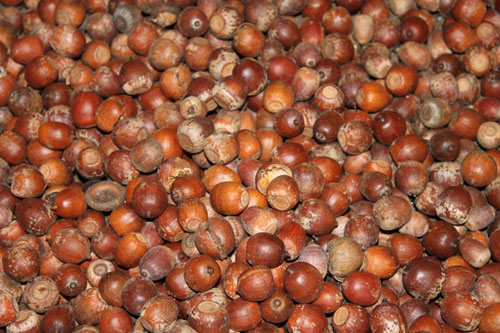TRENTON – Squirrels aren’t the only ones focused on acorns this fall. At the Department of Environmental Protection's Forest Nursery in Jackson, foresters and staff are hard at work collecting and sorting this year’s acorn crop in preparation for growing the next generation of oaks – trees that one day will spread shade, oxygen, and beauty across New Jersey.
“The trees that will sprout from these acorns will be planted in virtually every type of setting you can imagine – from cities like Newark to woods such as the pine-oak forest around the nursery that have been hit by gypsy moths in recent years,” said Joe Battersby, the nursery’s superintendent.
In less than a year, the oak saplings grown from the acorns collected this fall will be used to reforest state lands that have lost trees to insect infestations, disease and overgrazing by deer.
They also will be sold at production cost to property owners, environmental groups, civic groups and other state and federal agencies for reforestation efforts, both small-scale and large-scale. In this way, they will be helping thousands of people make connections to the land and to the environment they cherish.
The nursery, located in the northern Pinelands of Ocean County, sells trees to property owners who are planting them around their homes to reduce heating and cooling costs, to prevent erosion, to abate traffic noise, to serve as protective windbreaks – and simply because they value trees.
While the nursery grows a large variety of hardwoods and conifers for reforestation efforts, the oaks are among the most popular. People seem to have a strong connection to them because of their stately beauty, habitat values, and historic importance in helping build New Jersey, said Susan Pontoriero, a forestry technician at the nursery since 1978.
“Oaks are just cool,” she said. “The northern red oak is definitely the most popular because it’s our state tree. It’s especially popular with landowners in northern New Jersey, which is part of the range in which it does really well.”
But for all the different ways people are using trees today, the process for gathering the acorns to planting them has not changed much since the nursery got involved in reforestation efforts in 1907 with the goal or rebuilding New Jersey’s forest resources. This was a time when much of New Jersey’s woodlands had been cleared for farming, logging, charcoal production, and firewood. |
|
| Today, DEP forestry experts work to ensure the health of New Jersey’s woodlands, important to many New Jersey residents for recreation and solitude. The nursery is vital to this effort, ensuring a healthy supply when trees need to be replaced.
The nursery’s motto, “Seedlings today, forests tomorrow,” is at no time more evident than at this time of year, when acorns are collected and sorted to become the next generation of oaks.
The acorn-picking season gets into gear in September when workers fan out to state parks and forests from High Point to Cape May Point, using gathering machines – much like the old push-mowers of days past – to pick up tons of fallen acorns.
The season continues full swing through late November with workers busily picking out the best acorns to be planted in the nursery.
“The drought this summer actually helped with some species of acorn |
the nursery, the nuts are carted to a barn where workers, using scoops resembling coffee cans, pour fistfuls of acorns onto a metal slide, sending them skittering past a worker with a leaf-blower to buckets below. This step separates twigs, leaves and other debris from acorns.
From here,
the buckets
of acorns are poured into large tubs of water. The good acorns will sink. The bad ones, hallowed out by insects, will float. Depending on the species, some acorns are already being planted this fall while others will be stored for planting in the spring.
The time-honored process is worth the effort. Over its more than century-long history, the nursery has raised an estimated five millions oaks, including red oaks, pin oaks, white oaks, chestnut oaks, and black oaks. In all, New Jersey has a dozen species of oaks.
|
 |
Place cursor over images below to view larger image.
Click on image to open in full size. |
|
|
|
|
|
|
|
 |
|
production,” Battersby said. “Production is cyclical. Some years some species of oaks produce mediocre numbers of acorns while you'll get a boom with other species. The stars aligned this year for white and chestnut oaks. These species love dry conditions and really took off.”
Teachers often book field trips to the nursery through the Forest Resource Education Center, an interpretive center that shares the Jackson property. Students enjoy the hands-on experience of planting acorns in the nursery beds to grow the trees of tomorrow.
The process of sorting the acorns is a labor of love. Once brought back to |
Surprisingly, Battersby said, trees grow much more quickly than many people realize, and provide a true sense of satisfaction. In fact, acorns planted now will have grown to three feet high in a year under the nursery’s care.
People are now looking at trees in many different ways that represent a true turnaround from the way trees were treated at the beginning of the 20th century, Battersby said.
“Really, our reasons for panting trees run the spectrum,” Battersby said. “But, in some cases, folks just need a connection to the land. Trees help them make that connection.”
So do acorns. |
|